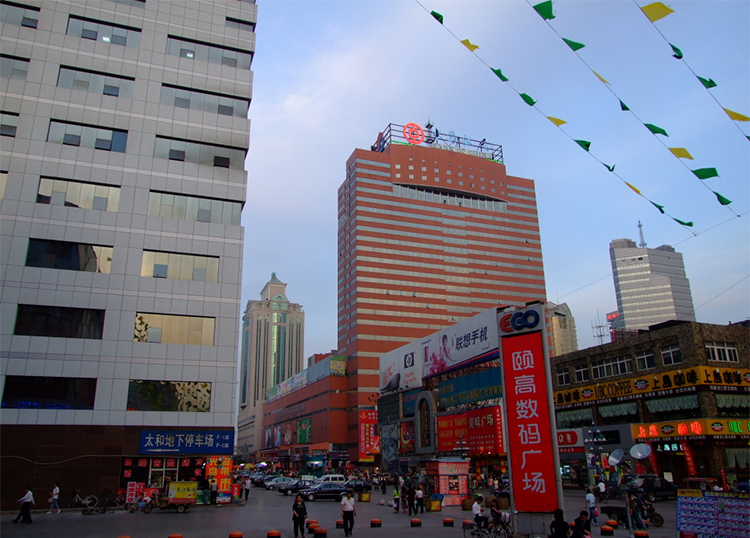Discover Minzu Road Pedestrian Street: Shijiazhuang’s Historic Shopping Street and Cultural Highlights
Minzu Road Pedestrian Street: Shijiazhuang’s Shopping & History
Stroll along Minzu Road Pedestrian Street in Shijiazhuang and you’ll feel like you’ve stepped through a time tunnel. This 1,080-meter boulevard is not only North China’s most renowned commercial artery but also a three-dimensional city storybook. When Republic-era brick-red buildings meet neon-lit modern storefronts, and century-old food shops stand side by side with creative new restaurants, Minzu Road vividly expresses Shijiazhuang’s openness as a “city pulled together by the railway.” Hosting over 20 million visitors a year as the city’s living room, Minzu Road invites every traveler to join its endless urban carnival with a one-of-a-kind mixed-style charm.
1. Centuries-old Commercial Heritage Reborn
The soul of Minzu Road lies in its balance of historic memory and contemporary vitality. The renovated street preserves the architectural texture from Shijiazhuang’s early-20th-century railway hub era: arched colonnades and bas-relief Republic-style façades now converse with glass-walled shopping centers. Don’t miss the dusk architectural projection show—black-and-white images of century-old shops roll across brick walls and create a cross-century visual symphony with LED displays from trendy stores. Locals love to bring children in the evening to watch the light art while shopping for the latest seasonal fashion—this everyday scene perfectly captures Shijiazhuang people’s fondness for the past and appetite for the new.
2. A Full-Spectrum Shopping Destination
As a commercial flagship for North China, Minzu Road offers everything from global fast-fashion to local time-honored brands. New Bai Plaza and Yinzuo Mall form two retail cores: the former hosts international names like ZARA and Uniqlo for basic shopping needs, while the latter focuses on beauty and designer boutiques. The real treasures, however, are among more than 300 independent stores. The Hebei Museum cultural flagship sells souvenirs inspired by artifacts such as the Changxin Palace lantern; Gaocheng Palace Noodles demonstrates provincial intangible-heritage noodle-making; Taihang Handcrafts gathers folk art like cloth tigers and straw-painting from across Hebei. Be sure to visit the Yanzhao Crafts Market on Saturdays to find unique souvenirs like Taihang walnut carvings.
3. A Culinary Corridor of Hebei Flavors
A 200-meter dining stretch serves as a micro-map of Hebei cuisine. Red Star Baozi continues a seventy-year fermentation method for its sauced meat buns, while Jinfeng Braised Chicken draws long queues with its century-old broth and marinated flavors. For a truly local “village taste,” try the beef zhahuoshao paired with clay-oven baked flatbread—the rustic combo is a regional favorite. Trendy newcomers shine too: Taihang Tea House mixes local Zhaozhou pear with jasmine tea in inventive blends, and Shimen Sugar Workshop revives candy-making techniques from classical literature. The dining area’s central garden is modeled on a train carriage, cleverly echoing the city’s railway history and offering a perfect photo backdrop.

4. An Immersive Urban Theatre
Beyond shopping, Minzu Road feels like a 24-hour urban stage. On the hour the fountain at Jiefang Square dances to patriotic melodies like “My Motherland and I”; street performer zones by the Dashi Bridge ruins often feature impromptu Hebei Bangzi opera; Yinzuo Mall’s rooftop Cloud Top Gallery hosts periodic pop-up exhibitions by young artists. A delightful surprise is the tucked-away Shimen Memory Museum, which uses AR technology to recreate early railway construction scenes—you can even operate an old ticket machine to print a souvenir ticket. After dark neon signs light up, night market stalls waft the scent of jianbing (savory pancakes), and Livehouses echo with rehearsal sounds—a reminder of why locals call Minzu Road “the city that never sleeps.”
5. Thoughtful Layout and Visitor Services
The street follows a fishbone-shaped layout: the wide, flat main avenue is stroller-friendly while side alleys hide specialty shops. All signage is bilingual (Chinese-English), and Metro Line 1’s Jiefang Square Station, Exit B, delivers you straight to the heart of the district. Download the “Minzu Road Smart District” mini-program for real-time shop locations, restroom maps, and promotions. In addition to Alipay and WeChat Pay, Yinzuo Mall and New Bai Plaza accept Visa and MasterCard. Photography tips: the Republic-era building zone has the best light between 9:00–10:00 AM; winter lighting typically turns on earlier—around 17:30 near the winter solstice.

Suggested Itineraries:
– Classic Half-Day: Jiefang Monument (30 min) → Main Street shopping (2 hours) → Jinfeng Braised Chicken lunch (1 hour) → Dashi Bridge ruins (30 min)
– Deep Full-Day: Morning crafts shopping + intangible-cultural workshop → Taihang Tea House afternoon tea → Shimen Memory Museum + Cloud Top Gallery → Evening light show + night market dinner
– Hidden Gem: Wednesday morning Silver Market caters to older visitors with nostalgic goods—find 1980s logos and vintage movie posters.
Standing on the stone balustrade of Dashi Bridge and looking back, Minzu Road Pedestrian Street is like a glowing river of stars—heavy, historic light on the left and a glittering galaxy of modern life on the right. There’s no need to “tour” it; the best way to experience Minzu Road is to be like a local—buy a cup of pear soup, stroll, and let the interwoven times wrap you gently. When the last subway of the night glides by, you’ll take home more than souvenirs—you’ll carry a little of this city’s warmth and stories.


